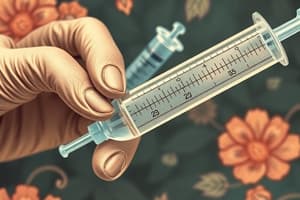Podcast
Questions and Answers
What is the proper injection angle for the intramuscular (IM) route?
What is the proper injection angle for the intramuscular (IM) route?
- 30°
- 60°
- 45°
- 90° (correct)
Which route involves injecting into the first layer of the skin?
Which route involves injecting into the first layer of the skin?
- Intravenous (IV)
- Subcutaneous (SubQ)
- Intradermal (ID) (correct)
- Intramuscular (IM)
For the subcutaneous (SubQ) route, what is the injection angle?
For the subcutaneous (SubQ) route, what is the injection angle?
- 90°
- 30°
- 45° (correct)
- 15°
The intravenous (IV) route is specifically meant for which type of administration?
The intravenous (IV) route is specifically meant for which type of administration?
What is the injection angle for the intradermal (ID) route?
What is the injection angle for the intradermal (ID) route?
What route of administration involves placing medication under the tongue?
What route of administration involves placing medication under the tongue?
Which route of administration is used for applying medication via an adhesive patch?
Which route of administration is used for applying medication via an adhesive patch?
At what angle should subcutaneous injections be administered?
At what angle should subcutaneous injections be administered?
What is the main advantage of the inhalation route of medication administration?
What is the main advantage of the inhalation route of medication administration?
Which injection route targets the first layer of skin?
Which injection route targets the first layer of skin?
For which type of administration would you use eye drops?
For which type of administration would you use eye drops?
What type of administration involves medication inserted into the rectum?
What type of administration involves medication inserted into the rectum?
What is the appropriate angle for an intramuscular injection?
What is the appropriate angle for an intramuscular injection?
Which route of administration involves injecting medication into a vein?
Which route of administration involves injecting medication into a vein?
What angle is used for intravenous injections?
What angle is used for intravenous injections?
What is the primary characteristic of sublingual administration?
What is the primary characteristic of sublingual administration?
Which route of administration involves inserting a drug into the rectum?
Which route of administration involves inserting a drug into the rectum?
Which of the following routes involves applying a medication directly onto the skin?
Which of the following routes involves applying a medication directly onto the skin?
Inhalation as a route of administration requires the drug to be delivered to which location?
Inhalation as a route of administration requires the drug to be delivered to which location?
What distinguishes a transdermal route of administration?
What distinguishes a transdermal route of administration?
What is the primary requirement for a medication to be classified as prescription?
What is the primary requirement for a medication to be classified as prescription?
Which of the following is another name for non-prescription medications?
Which of the following is another name for non-prescription medications?
Which of the following is NOT one of the three times you should check an ordered medication?
Which of the following is NOT one of the three times you should check an ordered medication?
Which of the following is included in the 'Rights of Medication Administration'?
Which of the following is included in the 'Rights of Medication Administration'?
Which of the following rights ensures the medication is given to the correct person?
Which of the following rights ensures the medication is given to the correct person?
What is the correct treatment for a mild allergic reaction?
What is the correct treatment for a mild allergic reaction?
Which symptom is NOT typically associated with a severe allergic reaction?
Which symptom is NOT typically associated with a severe allergic reaction?
What is a critical step to take if a patient has a severe allergic reaction?
What is a critical step to take if a patient has a severe allergic reaction?
During the documentation of a patient's allergies, which detail is least relevant?
During the documentation of a patient's allergies, which detail is least relevant?
What are common symptoms of a mild allergic reaction?
What are common symptoms of a mild allergic reaction?
What is the primary consideration when selecting a needle for an injection?
What is the primary consideration when selecting a needle for an injection?
In what units are most syringes measured?
In what units are most syringes measured?
How are needle diameters classified?
How are needle diameters classified?
What should be used for the disposal of needles?
What should be used for the disposal of needles?
What gauge is mentioned for pediatric needle use?
What gauge is mentioned for pediatric needle use?
What is the primary reason for sterilizing instruments before use?
What is the primary reason for sterilizing instruments before use?
Which of the following is NOT considered an unsafe injection practice?
Which of the following is NOT considered an unsafe injection practice?
What happens if proper documentation is not maintained in injection practices?
What happens if proper documentation is not maintained in injection practices?
Which of the following could potentially lead to infection during an injection procedure?
Which of the following could potentially lead to infection during an injection procedure?
What does the curved label on a syringe typically indicate?
What does the curved label on a syringe typically indicate?
What is the first step in preparing a vial for medication withdrawal?
What is the first step in preparing a vial for medication withdrawal?
What should you do after wiping the outside of an ampule before withdrawing medication?
What should you do after wiping the outside of an ampule before withdrawing medication?
What is necessary to do after withdrawing medication from a vial to ensure no air bubbles are present?
What is necessary to do after withdrawing medication from a vial to ensure no air bubbles are present?
Which of the following must be avoided when withdrawing medication from an ampule?
Which of the following must be avoided when withdrawing medication from an ampule?
What is the correct procedure to follow after withdrawing medication from an ampule?
What is the correct procedure to follow after withdrawing medication from an ampule?
Which of the following healthcare professionals utilizes CPOE?
Which of the following healthcare professionals utilizes CPOE?
What is one of the primary benefits of using CPOE?
What is one of the primary benefits of using CPOE?
Which step is NOT part of the telehealth/virtual visit process?
Which step is NOT part of the telehealth/virtual visit process?
What is a prerequisite before attending a telehealth visit?
What is a prerequisite before attending a telehealth visit?
Which of these statements about CPOE is correct?
Which of these statements about CPOE is correct?
Flashcards
Subcutaneous Injection
Subcutaneous Injection
Medication or fluid injected into the fatty tissue just under the skin.
Intradermal Injection
Intradermal Injection
Injection into the deepest layer of the skin.
Intramuscular Injection
Intramuscular Injection
Injection into the muscles.
Intravenous Injection
Intravenous Injection
Signup and view all the flashcards
Injection Angles
Injection Angles
Signup and view all the flashcards
SubQ Injection Angle
SubQ Injection Angle
Signup and view all the flashcards
Intradermal Injection Angle
Intradermal Injection Angle
Signup and view all the flashcards
IM Injection Angle
IM Injection Angle
Signup and view all the flashcards
IV Injection Location
IV Injection Location
Signup and view all the flashcards
IV Injection Angle
IV Injection Angle
Signup and view all the flashcards
Oral Route
Oral Route
Signup and view all the flashcards
Sublingual Route
Sublingual Route
Signup and view all the flashcards
Buccal Route
Buccal Route
Signup and view all the flashcards
Inhalation Route
Inhalation Route
Signup and view all the flashcards
Transdermal Route
Transdermal Route
Signup and view all the flashcards
Prescription Meds
Prescription Meds
Signup and view all the flashcards
Oral Route
Oral Route
Signup and view all the flashcards
Sublingual Route
Sublingual Route
Signup and view all the flashcards
Non-Prescription Meds
Non-Prescription Meds
Signup and view all the flashcards
Medication Checkpoints
Medication Checkpoints
Signup and view all the flashcards
Inhalation Route
Inhalation Route
Signup and view all the flashcards
Rights of Medication
Rights of Medication
Signup and view all the flashcards
Transdermal Route
Transdermal Route
Signup and view all the flashcards
Rectal Route
Rectal Route
Signup and view all the flashcards
Medication Administration Steps
Medication Administration Steps
Signup and view all the flashcards
Mild Allergic Reaction
Mild Allergic Reaction
Signup and view all the flashcards
Severe Allergic Reaction
Severe Allergic Reaction
Signup and view all the flashcards
Anaphylaxis
Anaphylaxis
Signup and view all the flashcards
Allergy Documentation
Allergy Documentation
Signup and view all the flashcards
Epinephrine Treatment
Epinephrine Treatment
Signup and view all the flashcards
Instrument Sterilization
Instrument Sterilization
Signup and view all the flashcards
Unsafe Injection Practice
Unsafe Injection Practice
Signup and view all the flashcards
Syringe Label 1.25
Syringe Label 1.25
Signup and view all the flashcards
Documentation
Documentation
Signup and view all the flashcards
Reusing Needles
Reusing Needles
Signup and view all the flashcards
Needle Disposal Method
Needle Disposal Method
Signup and view all the flashcards
Needle Selection Factors
Needle Selection Factors
Signup and view all the flashcards
Syringe Measurement Unit (general)
Syringe Measurement Unit (general)
Signup and view all the flashcards
Subcutaneous Injection Angle
Subcutaneous Injection Angle
Signup and view all the flashcards
Intramuscular Injection Angle
Intramuscular Injection Angle
Signup and view all the flashcards
Vial Withdrawal
Vial Withdrawal
Signup and view all the flashcards
Ampule Preparation
Ampule Preparation
Signup and view all the flashcards
Vial Preparation
Vial Preparation
Signup and view all the flashcards
Ampule Safety
Ampule Safety
Signup and view all the flashcards
Air Bubble Removal
Air Bubble Removal
Signup and view all the flashcards
Telehealth Visit Steps
Telehealth Visit Steps
Signup and view all the flashcards
CPOE
CPOE
Signup and view all the flashcards
Telehealth Limitations
Telehealth Limitations
Signup and view all the flashcards
CPOE Benefits
CPOE Benefits
Signup and view all the flashcards
Who uses CPOE?
Who uses CPOE?
Signup and view all the flashcards




